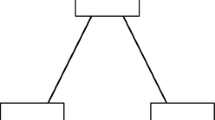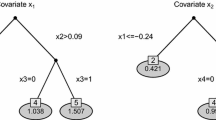Abstract
In many areas of psychology, correlation-based network approaches (i.e., psychometric networks) have become a popular tool. In this paper, we propose an approach that recursively splits the sample based on covariates in order to detect significant differences in the structure of the covariance or correlation matrix. Psychometric networks or other correlation-based models (e.g., factor models) can be subsequently estimated from the resultant splits. We adapt model-based recursive partitioning and conditional inference tree approaches for finding covariate splits in a recursive manner. The empirical power of these approaches is studied in several simulation conditions. Examples are given using real-life data from personality and clinical research.







Similar content being viewed by others
Notes
Occasionally, altering \(\varvec{\rho }\) caused \({\mathbf {R}}\) to be non-positive-definite, in which case we located an approximate positive definite solution or discarded the case if an approximate case could not be found.
References
American Psychiatric Association. (2013). Diagnostic and statistical manual of mental disorders (DSM-5\(\textregistered \)). Washington: American Psychiatric Publishing.
Andrews, D. W. K. (1993). Tests for parameter instability and structural change with unknown change point. Econometrica, 61, 821–856.
Boker, S. M., & Martin, M. (2018). A conversation between theory, methods, and data. Multivariate Behavioral Research, 53(6), 806–819.
Borsboom, D. (2017). A network theory of mental disorders. World Psychiatry, 16, 5–13.
Brandmaier, A. M., von Oertzen, T., McArdle, J. J., & Lindenberger, U. (2013). Structural equation model trees. Psychological Methods, 18(1), 71.
Breiman, L., Friedman, J. H., Olshen, R. A., & Stone, C. J. (1984). Classification and regression trees. New York: Chapman & Hall/CRC.
Brown, T. A., Chorpita, B. F., Korotitsch, W., & Barlow, D. H. (1997). Psychometric properties of the depression anxiety stress scales (DASS) in clinical samples. Behaviour Research and Therapy, 35, 79–89.
Cabrieto, J., Tuerlinckx, F., Kuppens, P., Wilhelm, F. H., Liedlgruber, M., & Ceulemans, E. (2018). Capturing correlation changes by applying kernel change point detection on the running correlations. Information Sciences, 447, 117–139.
Costantini, G., Richetin, J., Preti, E., Casini, E., Epskamp, S., & Perugini, M. (2019). Stability and variability of personality networks. A tutorial on recent developments in network psychometrics. Personality and Individual Differences, 136, 68–78.
Dalege, J., Borsboom, D., van Harreveld, F., van den Berg, H., Conner, M., & van der Maas, H. L. (2016). Toward a formalized account of attitudes: The causal attitude network (CAN) model. Psychological Review, 123, 2–22.
Drasgow, F. (1986). Polychoric and polyserial correlations. In S. Kotz & N. L. Johnson (Eds.), Encyclopedia of statistical sciences (Vol. 7, pp. 68–74). New York: Wiley.
Epskamp, S., Borsboom, D., & Fried, E. I. (2018). Estimating psychological networks and their accuracy: A tutorial paper. Behavior Research Methods, 50, 195–212.
Epskamp, S., Cramer, A. O. J., Waldorp, L. J., Schmittmann, V. D., & Borsboom, D. (2012). qgraph: Network visualizations of relationships in psychometric data. Journal of Statistical Software, 48(4), 1–18.
Epskamp, S., Rhemtulla, M., & Borsboom, D. (2017). Generalized network psychometrics: Combining network and latent variable models. Psychometrika, 82, 904–927.
Fokkema, M., Smits, N., Zeileis, A., Hothorn, T., & Kelderman, H. (2018). Detecting treatment-subgroup interactions in clustered data with generalized linear mixed-effects model trees. Behavior Research Methods, 50, 2016–2034.
Fried, E. I., & Nesse, R. M. (2015). Depression is not a consistent syndrome: An investigation of unique symptom patterns in the STAR*D study. Journal of Affective Disorders, 172, 96–102.
Friedman, J., Hastie, T., & Tibshirani, R. (2008). Sparse inverse covariance estimation with the graphical lasso. Biostatistics, 9, 432–441.
Fritz, J., Fried, E. I., Goodyer, I. M., Wilkinson, P. O., & van Harmelen, A.-L. (2018). A network model of resilience factors for adolescents with and without exposure to childhood adversity. Scientific Reports, 8, 15774.
Gosling, S. D., Rentfrow, P. J., & Swann, W. B, Jr. (2003). A very brief measure of the Big-Five personality domains. Journal of Research in Personality, 37, 504–528.
Hanley, G. P., Iwata, B. A., & McCord, B. E. (2003). Functional analysis of problem behavior: A review. Journal of Applied Behavior Analysis, 36, 147–185.
Hansen, B. E. (1997). Approximate asymptotic \(p\) values for structural-change tests. Journal of Business & Economic Statistics, 15, 60–67.
Haslbeck, J., & Fried, E. I. (2017). How predictable are symptoms in psychopathological networks? A reanalysis of 18 published datasets. Psychological Medicine, 47, 2767–2776.
Haslbeck, J. M. B., Borsboom, D., & Waldorp, L. J. (2019). Moderated network models. Multivariate Behavioral Research. https://doi.org/10.1080/00273171.2019.1677207.
Hjort, N. L., & Koning, A. (2002). Tests for constancy of model parameters over time. Nonparametric Statistics, 14, 113–132.
Hothorn, T., Hornik, K., van de Wiel, M. A., & Zeileis, A. (2006a). A lego system for conditional inference. The American Statistician, 60, 257–263.
Hothorn, T., Hornik, K., & Zeileis, A. (2006b). Unbiased recursive partitioning: A conditional inference framework. Journal of Computational and Graphical Statistics, 15, 651–674.
Hothorn, T., & Zeileis, A. (2015). partykit: A modular toolkit for recursive partytioning in R. Journal of Machine Learning Research, 16, 3905–3909.
Jones, P., Simon, T., & Zeileis, A. (2018). networktree: Recursive Partitioning of Network Models. R package version 1.0.0.
Jones, P. J., Heeren, A., & McNally, R. J. (2017). Commentary: A network theory of mental disorders. Frontiers in Psychology, 8, 1305.
Komboz, B., Strobl, C., & Zeileis, A. (2018). Tree-based global model tests for polytomous Rasch models. Educational and Psychological Measurement, 78, 128–166.
Mair, P., & De Leeuw, J. (2010). A general framework for multivariate analysis with optimal scaling: The R package aspect. Journal of Statistical Software, 32, 1–23.
Marsman, M., Borsboom, D., Kruis, J., Epskamp, S., van Bork, R., Waldorp, L., et al. (2018). An introduction to network psychometrics: Relating ising network models to item response theory models. Multivariate Behavioral Research, 53, 15–35.
McNally, R. J. (2019). The network takeover reaches psychopathology. Behavioral and Brain Sciences, 42, e15.
Merkle, E. C., Fan, J., & Zeileis, A. (2014). Testing for measurement invariance with respect to an ordinal variable. Psychometrika, 79, 569–584.
Merkle, E. C., & Shaffer, V. A. (2011). Binary recursive partitioning methods with application to psychology. British Journal of Mathematical and Statistical Psychology, 64, 161–181.
Merkle, E. C., & Zeileis, A. (2013). Tests of measurement invariance without subgroups: A generalization of classical methods. Psychometrika, 78, 59–82.
Molenaar, P. C. (2004). A manifesto on psychology as idiographic science: Bringing the person back into scientific psychology, this time forever. Measurement, 2, 201–218.
Park, J. H., & Sohn, Y. (2019). Detecting structural changes in longitudinal network data. Bayesian Analysis, 15, 133–157.
R Development Core Team. (2020). R: A Language and Environment for Statistical Computing. Vienna, Austria: R Foundation for Statistical Computing. ISBN 3-900051-07-0.
Salters-Pedneault, K., Tull, M. T., & Roemer, L. (2004). The role of avoidance of emotional material in the anxiety disorders. Applied and Preventive Psychology, 11, 95–114.
Schaefer, J., Opgen-Rhein, R., & Strimmer, K. (2015). GeneNet: Modeling and inferring gene networks. R package version, 1(2), 13.
Schaefer, J., & Strimmer, K. (2004). An empirical bayes approach to inferring large-scale gene association networks. Bioinformatics, 21, 754–764.
Schlosser, L., Hothorn, T., and Zeileis, A. (2019). A unifying view of CTree, MOB, and GUIDE. arXiv:1906.10179, E-Print Archive.
Seibold, H., Zeileis, A., & Hothorn, T. (2016). Model-based recursive partitioning for subgroup analyses. The International Journal of Biostatistics, 12, 45–63.
Strasser, H., & Weber, C. (1999). On the asymptotic theory of permutation tests. Mathematical Methods of Statistics, 8, 220–250.
Strobl, C., Kopf, J., & Zeileis, A. (2015). Rasch trees: A new method for detecting differential item functioning in the Rasch model. Psychometrika, 80, 289–316.
Strobl, C., Malley, J., & Tutz, G. (2009). An introduction to recursive partitioning: Rationale, application, and characteristics of classification and regression trees, bagging, and random forests. Psychological Methods, 14, 323–348.
Strobl, C., Wickelmaier, F., & Zeileis, A. (2011). Accounting for individual differences in Bradley–Terry models by means of recursive partitioning. Journal of Educational and Behavioral Statistics, 36, 135–153.
van Borkulo, C. D., Boschloo, L., Kossakowski, J. J., Tio, P., Schoevers, R. A., Borsboom, D., & Waldorp, L. J. (2017). Comparing network structures on three aspects: A permutation test. Journal of Statistical Software. Forthcoming.
Wang, T., Merkle, E. C., & Zeileis, A. (2014). Score-based tests of measurement invariance: Use in practice. Frontiers in Psychology, 5, 1–11.
Wickelmaier, F., & Zeileis, A. (2018). Using recursive partitioning to account for parameter heterogeneity in multinomial processing tree models. Behavior Research Methods, 50, 1217–1233.
Williams, D. R., Rast, P., Pericchi, L. R., & Mulder, J. (2020). Comparing Gaussian graphical models with the posterior predictive distribution and Bayesian model selection. Psychological Methods, 25, 653–672.
Zeileis, A. (2006). Implementing a class of structural change tests: An econometric computing approach. Computational Statistics & Data Analysis, 50, 2987–3008.
Zeileis, A., & Hornik, K. (2007). Generalized \(M\)-fluctuation tests for parameter instability. Statistica Neerlandica, 61, 488–508.
Zeileis, A., Hothorn, T., & Hornik, K. (2008). Model-based recursive partitioning. Journal of Computational and Graphical Statistics, 17, 492–514.
Acknowledgements
P. Jones acknowledges funding from the National Science Foundation (GRFP, Grant No. DGE1745303). T. Simon acknowledges funding from the Austrian Science Fund (FWF, Grant No. P31836).
Author information
Authors and Affiliations
Corresponding author
Additional information
Publisher's Note
Springer Nature remains neutral with regard to jurisdictional claims in published maps and institutional affiliations.
Appendix: Score Functions of the Multivariate Gaussian Distribution
Appendix: Score Functions of the Multivariate Gaussian Distribution
We derive the score functions of the multivariate Gaussian distribution for individual observations. In order to fit the networktree model described in the paper, one only requires the score functions of the correlation parameters. However, for the sake of completeness the score functions for all parameters, i.e., mean, standard deviation, and correlations, are derived. The first derivatives of the log-likelihood, as given in Eq. (2), w.r.t. the parameters \(\mu _k\), \(\sigma _k\), and \(\rho _{kl}\) are given below. Note that we use the scalar parameter expressions rather than vector notation. The partial derivative w.r.t. \(\mu _k\) is:
where \(\varsigma _{kl}\) denotes the element in the k-th row and l-th column of the inverse of the covariance matrix \(\varvec{\Sigma }^{-1}\). The partial derivative w.r.t. \(\sigma _k\) is:
where \(\omega _{kl}\) denotes the element in the k-th row and l-th column of the inverse of the correlation matrix \(\mathbf {R}^{-1}\). Finally, the partial derivative w.r.t. \(\rho _{kl}\) is:
Note that these are the ones used in our NT approach.
Rights and permissions
About this article
Cite this article
Jones, P.J., Mair, P., Simon, T. et al. Network Trees: A Method for Recursively Partitioning Covariance Structures. Psychometrika 85, 926–945 (2020). https://doi.org/10.1007/s11336-020-09731-4
Received:
Revised:
Accepted:
Published:
Issue Date:
DOI: https://doi.org/10.1007/s11336-020-09731-4




